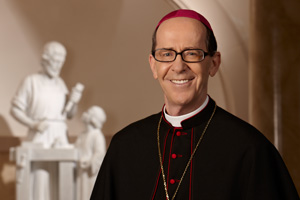Singing the Mass — Part Three
In the first part of this series on sacred music, I described the meaning of sacred music, and the difference between the music of the Church’s sacred liturgy and “religious music” (Dec. 15, 2011). The second part explored, from a historical perspective, the Church’s role in preserving and fostering authentic sacred music for more fruitful participation in the Sacred Mysteries (Jan. 19). In this third part, we now look at the role of sacred music in evangelizing culture.
EN ESPAÑOL: El papel de la Música Sagrada en la Evangelización
Evangelization and inculturation

Evangelization, the proclamation of the good news of Jesus Christ, is closely linked to what the Church calls inculturation. Inculturation is the process by which “the Church makes the Gospel incarnate in different cultures and at the same time introduces peoples, together with their cultures, into her own community.” This process brings about “an intimate transformation of the authentic cultural values” (Redemptoris Missio, 52).
We see here a double movement — the interplay of two profound mysteries of faith: the Incarnation (characterized by an earth-ward movement and proclamation) and the Paschal Mystery (characterized by a heaven-ward movement and transformation). This double movement is all the work of Christ: As the Eternal Word He enters our history, becoming flesh in the Incarnation; and then He suffers, dies, rises, and ascends into Heaven, to draw all people to Himself.
Like Christ and in Him, the Church engages authentic human culture wherever she finds it. She proclaims the good news of Jesus Christ to a specific culture; and then whatever is good in the culture she purifies and transforms, drawing it into her own communal life in her various ecclesial “rites” (in our case, the Roman Rite).
Music and inculturation
The distinction between religious music and liturgical music (cf. part one of this series) embodies this double movement: religious music is, we might say, the earthly expression of a given culture’s faith in Christ; liturgical music is the sacramental expression of Christ and the true nature of the Church. The former tends to be particular, individual, temporal and profane; the latter tends to be universal, communal, eternal and sacred. Religious music comes from human hearts yearning for God; liturgical music comes from Christ’s heart, the heart of the Church, longing for us.
Because religious music is marked by the particular and profane, it is especially useful for evangelization. Like St. Francis Xavier donning the silk garments of Japanese nobility in his missionary work in Japan, religious music “wears the clothes” of those it seeks to evangelize; it becomes familiar, taking in much of the cultural forms, and where possible doing this with minimal alteration. In religious music, the Church learns to sing, in many voices, through the familiar melodies and rhythms of various cultures.
But in the sacred liturgy, we enter the precincts not of man’s culture but the heavenly courts of Christ, the culture of the Church, the wedding feast of the Lamb: and new festive garments are required for this feast (cf. Mt 22:1-14). In liturgical music, the peoples drawn into the sacred liturgy learn to sing, in one voice, through the often unfamiliar melody and rhythm of the Church’s sacred music. This oneness is exemplified (for us Roman Rite Catholics) primarily in Gregorian Chant and Polyphony, the musical “garments” of the texts of the sacred liturgy.
The genius of the Roman Rite
The new English translation of the Mass has powerfully reminded us that authentic liturgy comes to us through the unity and integrity of the Roman Rite (Liturgiam Authenticam, 4). The liturgy of the Roman Rite is a “precious example and an instrument of true inculturation” because of its amazing ability of “assimilating into itself spoken and sung texts” (Ibid, 5). Inculturation, in the liturgical (and musical) sense, is finally about the assimilation of peoples, cultures, and even musical forms into the already given form of the Roman Rite.
Some might ask: should not the mention of the word assimilation give us pause, or even make us somewhat nervous? If we submit ourselves to this assimilation — with all our musical preferences, tastes, and cultural differences — to the concrete musical sources of the Church’s liturgy (i.e., the Roman Missal itself, Graduale Romanum, Graduale Simplex, vernacular translations and adaptations thereof, etc.), will we not entirely lose ourselves, our individuality and creativity? Is there not a danger of the Church becoming irrelevant and therefore powerless in her liturgical expressions, a mere museum of “old” music?
To answer these concerns, we could extend the Church’s teaching on the new translation to the use of liturgical music:
“So the liturgy of the Church must not be foreign to any country, people or individual, and at the same time it should transcend the particularity of race and nation. It must be capable of expressing itself in every human culture, all the while maintaining its identity through fidelity to the tradition which comes to it from the Lord” (Liturgiam Authenticam, 4).
In other words, the Church, though existing in many cultures, has her own authentic culture because she has authentic liturgy … both which come to her from Christ. The unity and integrity of the Roman Rite is embodied in the Rite’s sacred texts and musical forms, as a vine is expressed in its branches. Growth requires pruning and nourishing, but never ignoring or starting from scratch.
The sacred liturgy — and sacred music — does not exhaust the entire work of the Church, not even of the Church’s work of evangelization. Religious music (outside the sphere of the liturgy) is absolutely necessary for pre-evangelization and evangelization. But it is not enough. It must lead to authentic liturgical music, concretely embodied in the music of the Roman Rite. The liturgical music of the Roman Rite bears unparalleled witness to the assimilating power of Christ, and His power to engage, purify, transform, and assimilate human culture into the culture of the Church.
In the end, it is precisely this assimilating power of heaven’s beauty — and not our own efforts or preferences — that brings about the true end of evangelization: to reconcile all things to God in Christ (Col 1:20).
In the fourth and final part in this series, we will consider practical ways in which we can deepen our experience of sacred music in the liturgy and in our lives.





![[VIDEO] Make Sunday feel like Sunday again](https://www.catholicsun.org/wp-content/uploads/2021/04/2021-YOUTUBE-BISHOP-MESSAGE-THUMBNAIL-ENGLISH-218x150.png)
